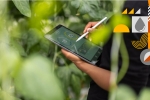Executive summary
Africa’s E&M sector shows strong digital-driven growth
The African E&M sectors in South Africa, Nigeria and Kenya continue to outperform global benchmarks, displaying resilience in the face of ongoing macroeconomic challenges. In 2024, Nigeria led the region with a remarkable 11.2% growth rate, followed by Kenya at 7.1% and South Africa at 6.2%. Looking ahead, the compound annual growth rate (CAGR) through 2029 is projected to be 7.2% for Nigeria, 5.2% for Kenya and 3.5% for South Africa, indicating sustained momentum across all three markets.
Digital demand reshapes the market
A key driver of this growth is the rapid expansion of internet advertising, particularly in Nigeria and Kenya, where mobile-first internet usage is accelerating. Kenya stands out globally, with its internet advertising market projected to grow at a CAGR of 16%—the fastest globally. OTT services are growing at a CAGR of 6.7% in South Africa, 8% in Nigeria and 11.2% in Kenya, reflecting strong consumer demand for digital content.
AI, live entertainment and the return of experience
GenAI is emerging as a transformative force in the E&M industry, enhancing content creation, recommendation engines and customer engagement. Nigeria, with its youthful and tech-savvy population, is particularly well-positioned to harness GenAI’s potential. Live entertainment is also rebounding, with live music revenues surpassing pre-pandemic levels and esports gaining momentum across the region.
Mauritius: Tracking new emerging markets
Mauritius is referenced in this year’s introduction as a signal of the expanding scope of Africa’s E&M landscape. While not analysed in detail in this edition, its inclusion reflects growing interest in smaller, emerging markets that are beginning to show digital momentum. With digital media consumption rising and internet advertising driving revenue, Mauritius is projected to grow at a 2.2% CAGR through 2029, reaching a market value of $508m. Its trajectory offers a glimpse into how peripheral markets may evolve and contribute to the continent's broader digital transformation.
Global shifts...local impact
The global economy is undergoing significant transformation, unlocking great value across all industries. The E&M sector remains a key player in this shift, positioned at the intersection of technological convergence and evolving consumer behaviour. This year’s analysis highlights several critical themes shaping the future of the industry.
Regulatory changes and tariffs are emerging as major obstacles to growth, creating substantial headwinds for expansion. At the same time, it remains a fundamental challenge to persuade consumers to allocate a larger portion of their discretionary income to E&M offerings, especially in an environment marked by economic uncertainty and inflationary pressures. Advertising has already become the dominant source of direct revenue in the E&M sector and is now the primary driver of global growth.The gap is expected to widen further, with global advertising growing at a CAGR of 6.1%, compared to just 2.0% for consumer spending. By 2029, global advertising revenue is projected to exceed consumer spending by more than $300b.
Generational differences in how people consume E&M products—particularly in gaming—are reshaping value chains and elevating new market leaders. AI is also poised to play a transformative role, especially in advertising, where it acts as a catalyst for creativity and efficiency. Despite these innovations, the annual rate of revenue growth is expected to decline throughout the forecast period, primarily due to constraints on consumer spending.
Global advertising spend surpasses consumer spending

Gaming and esports are on track to overtake traditional television globally by 2029, driven by the rapid expansion of mobile platforms, broader internet access and the rise of immersive technologies like virtual and augmented reality. These shifts are fuelling deeper engagement and higher spend, particularly among a younger, digitally native audiences who favour interactive and personalised experiences over passive viewing. Nigeria emulates this global trend, but one year earlier, with gaming and esports taking the lead in 2028. Globally, OTT subscription revenue is also forecast to exceed traditional subscription revenue in 2027.
Beyond macroeconomic factors, another key reason for the slowdown in consumer spending is the increasing need for digital access. Connectivity—defined as revenue from fixed and mobile internet services—remains the largest segment of the E&M industry. Driven largely by mobile services, spending on connectivity is projected to exceed $1.3t by 2029, underscoring its foundational role in the digital economy.
Market highlights
South Africa
Total E&M revenue in South Africa (US$ m)

Total E&M revenue in South Africa (ZAR m)

Selected E&M sub-segments

South Africa, the most mature E&M market in the region, is projected to grow at a 3.5% CAGR. While its growth rate is slower, it remains the regional leader in scale and infrastructure. OTT streaming and internet advertising are among the fastest-growing segments, supported by stable internet connectivity and increasing 5G adoption. Pay-TV remains a significant sector, with platforms like DStv maintaining sizable, and attractive, subscriber bases as seen by the recent CANAL+ acquisition. South Africa is also leading the continent in video games and esports, with mobile gaming dominating—driven by affordability and accessibility.
Economic challenges—including currency volatility and inflation—continue to weigh on consumer spending. South Africa remains a dynamic market, but growth is tempered by structural challenges and a comparatively older population, which shapes the pace of digital adoption.
By 2028, the advertising industry will reach the digital tipping point for consumer magazines with digital ad revenue surpassing print ad revenue for the first time. This shift reflects the ongoing migration of consumer attention and advertiser budgets to digital platforms, driven by factors such as enhanced targeting capabilities, measurable ROI and the decline of traditional print media consumption.
In the same year, Digital Out-of-Home (DOOH) advertising will overtake physical out-of-home (OOH) advertising formats, becoming the dominant segment within the OOH market. DOOH leverages digital screens and dynamic content to engage audiences more effectively, allowing for real-time updates, targeted messaging and interactive experiences.
In 2027, 5G subscription technology is expected to surpass 3G subscriptions in terms of adoption and usage, underscoring a major advancement in mobile connectivity. This shift highlights the accelerated rollout of faster, more reliable networks that support high-bandwidth applications such as streaming, gaming and IoT services. The transition from 3/4G to 5G will enable enhanced user experiences, greater network efficiency, and drive wider digital transformation across industries and consumer markets. While 4G will remain the dominant mobile technology throughout the forecast period, its growth is expected to plateau and begin declining by 2029. Based on current trajectories, 5G is set to overtake it shortly after the forecast window.
South Africa’s E&M market stands out for its scale, maturity and connectivity infrastructure. Internet advertising, OTT streaming and mobile gaming adoption drive growth.
Mobile network subscriptions: 3G vs 4G vs 5G

Nigeria
Total E&M revenue in Nigeria (US$ m)

Selected E&M sub-segments

Nigeria remains the fastest-growing E&M market in Africa. This growth is fuelled by rapid expansion in internet advertising, video games and esports, OTT streaming, and audio content such as music, radio and podcasts. Mobile internet and video streaming are expected to lead growth, fuelled by cheaper data plans and smartphone penetration. Gaming and social media advertising are also gaining traction, especially among gen z and millennial audiences. While infrastructure remains a challenge, the pace of digital innovation is outpacing the obstacles.
This rapid expansion is underpinned by the country’s population size, the largest in Africa, and an exceptionally young median age that fuels demand for digital content across all sectors.
Traditional media, like print media, continue to decline due to the ongoing migration to digital formats, with newspapers and magazines seeing a consistent drop in circulation and advertising revenue. Similarly, terrestrial TV and radio are showing slower growth as audiences, especially younger ones, transition to online and satellite alternatives, although these traditional media sources still hold relevance in rural and underserved regions.
Infrastructure challenges remain, particularly in rural areas, but ongoing investment in fibre rollout and 5G deployment is expected to improve connectivity and unlock new digital experiences.
Funding opportunities are emerging in local content production, influencer marketing and immersive tech, with both domestic and international investors showing interest. The key to unlocking Nigeria’s E&M potential lies in scalable digital infrastructure, regulatory clarity and inclusive access—especially for underserved communities.
Nigeria’s E&M growth is driven by a predominantly young population and rapid digital innovation that’s reshaping how content is created, consumed and monetised.
Kenya
Total E&M revenue in Kenya (US$ m)

Selected E&M sub-segments

Kenya, though the smallest of the three markets, is forecast to grow at a 5.2% CAGR. It is home to the fastest-growing internet advertising market in the world, with a projected CAGR of 16%. OTT streaming services are also expanding rapidly, supported by rising smartphone adoption and improved connectivity. Kenya’s gaming landscape continues to rise in social and casual gaming with a CAGR of 10.1% followed by a CAGR of 5.1% in the traditional gaming sector.
This robust expansion is fuelled primarily by the country’s youthful demographic and remarkable mobile-first internet adoption. The mobile penetration rate is high, driven by affordable smartphones and widespread mobile network coverage. Kenya’s proven integration of mobile money services, such as M-Pesa, with entertainment platforms creates a fertile environment for monetising mobile gaming and digital content in innovative ways. However, infrastructural challenges such as internet stability and intermittent electricity supply remain constraints.
With internet advertising and mobile gaming leading the way, Kenya’s digital media market is entering a new phase of growth.
Three markets. Diverging models
When comparing the three markets, South Africa emerges as the most mature and formalised entertainment and media ecosystem, with moderate growth driven by hybrid traditional-digital consumption and an established pay-TV sector. Meanwhile, Kenya and Nigeria are emblematic of the continent’s high-growth, mobile-centric future.
Against global trends, Africa generally lags in fixed broadband infrastructure and per capita subscription revenues but leads significantly in mobile internet adoption, mobile money-driven monetisation models and localised content production. Unlike mature markets in Europe or North America where subscription video on demand (SVOD) and digital advertising markets are saturated, African markets are still in early but accelerated growth stages, with demographics heavily favouring the young and mobile-connected populations. However, infrastructural inconsistencies and economic variability remain ongoing challenges that influence market development differently across these territories.
Connectivity and data consumption
Internet connectivity in South Africa, Kenya and Nigeria has experienced significant growth, primarily driven by mobile access and rising demand for digital services. Nigeria leads Africa with an estimated 107m¹ of its population online, reflecting a penetration rate of about 45.4%¹. South Africa has over 50m¹ users (representing a 78.9%² penetration), benefiting from more developed infrastructure and higher urban penetration, while Kenya, with a smaller user base, has a strong mobile-first approach reflected in its 48%² mobile internet penetration.
Mobile phones dominate internet access across all three countries, with smartphones serving as the primary gateway due to affordability and widespread mobile broadband. Fixed-line internet remains limited, particularly in rural areas, constrained by infrastructure challenges and higher costs. South Africa exhibits the highest fixed broadband penetration among the three, mostly in urban areas with advanced fibre deployments, however, mobile access still accounts for about 90% of connections. Nigeria’s fixed broadband penetration is concentrated in major cities, with fixed wireless solutions slowly emerging but not yet widespread. Kenya’s fixed broadband rollout faces challenges despite government efforts and funding, with fixed wireless access expected to remain the main fixed broadband method.
Data consumption is heavily influenced by video content and OTT services. In South Africa, video accounts for over 76% of all data usage, with platforms like TikTok and Instagram driving growth. Nigeria shows strong data consumption in gaming and streaming, while Kenya is experiencing rapid expansion in OTT services and internet advertising.
Between 2024 and 2029, data consumption is projected to increase substantially in all three markets. South Africa expects mobile internet penetration to rise by 2029, with mobile data traffic growing in line with expanding 4G and 5G networks and increased digital service demand. This growth is fuelled by the widespread adoption of internet-connected devices and the popularity of high-bandwidth applications like video streaming and social media platforms such as WhatsApp, TikTok and Facebook.
Internet connectivity revenue growth over the next five years

In Nigeria, internet access is also predominantly mobile, with most users connecting through mobile networks amid ongoing 4G expansion and nascent 5G trials. Starting from a relatively modest level in 2024, Nigeria’s data consumption is projected to more than triple, growing at a CAGR of 25.4% to reach 58.2k petabytes (PB) by 2029. Wi-Fi networks will continue to dominate data usage, with their share of total traffic increasing from 65.2% in 2024 to 73.1% in 2029, driven by wider availability of affordable and free hotspot access points. Wi-Fi traffic is projected to grow at a CAGR of 28.3%, tripling over the forecast period. Cellular data traffic is also expected to more than double, reaching 11.6k petabytes (PB) by 2029.
Kenya follows a similar mobile-first trajectory, with data consumption expected to grow significantly between 2024 and 2029, driven by increased mobile internet usage, expanding 4G coverage and the rollout of 5G services. Mobile connectivity remains dominant, with over 72m cellular connections already surpassing the population. Wi-Fi usage is also on the rise, supported by government investments in broadband infrastructure and Safaricom’s focus on 5G-powered fixed Wi-Fi services. Affordable access to smartphones, laptops and tablets is fuelling growth across device categories.
In South Africa video streaming is a major driver of data traffic, with platforms like Netflix and Spotify contributing to rising demand for high-speed internet. Social media usage is also strong, with millions of active users and platforms like YouTube and Facebook reaching a large portion of the population. Gaming and cloud-based entertainment are emerging as new growth areas. While 5G adoption is still in its early stages, it is expected to accelerate, with projections indicating 9.2m 5G subscriptions by 2025 and 5G accounting for 36.1% % of overall subscriptions by 2029.
Internet access dominates the E&M sector for all 3 African countries

One of the key challenges within the African markets is the quantum of spend directed towards getting online—Nigeria is most pronounced at 81%, followed by Kenya at 76% and South Africa at 62%. Globally, connectivity accounts for only about 40% of spend which translates into more spend being available for content and advertising. As disposable income grows within Africa and the relative cost of connectivity decreases, this will bode well for consumer and advertising spend which will attract an increasing share of wallet.
Consumer spending
From streaming to staging: Real experiences, real people
The live and in-person events sector in Kenya, Nigeria and South Africa is set to consolidate its steady recovery and growth following disruptions caused by the COVID-19 pandemic. In 2024, live music ticket sales in South Africa generated $76m (R1.4b) in revenue, with a projected CAGR of 5.9% through 2029. Both Kenya and Nigeria generated $1m in live music ticket sales revenue, but Kenya is edging ahead with a projected CAGR of 2.1%, slightly outpacing Nigeria’s 1.8%. This continued expansion is being driven by rising disposable incomes, a growing youth demographic and increased urbanisation. Live music events are thriving across the continent, with South Africa continuing to lead the way thanks to its well-established entertainment infrastructure. The country regularly hosts internationally renowned artists and festivals such as Ultra South Africa—Africa’s edition of the iconic EDM festival. Featuring world-class DJs such as Armin van Buuren, David Guetta and South Africa’s own Black Coffee, these events deliver high-energy performances with cutting-edge visuals, reinforcing South Africa’s position as the region’s live entertainment hub.
Kenya and Nigeria are also stepping up their investment in live music and festival culture, driven by expanding middle-class populations and a growing appetite for Afrobeat and regional genres. Both markets have surpassed pre-pandemic revenue levels, indicating a strong rebound in in-person entertainment. This resurgence is increasingly amplified by digital platforms and social media, which help drive attendance, fan engagement and visibility for local and international acts.
This revival of live entertainment is complemented by the rapid growth of music streaming across the region. In South Africa, consumer streaming revenue accounted for 36% of total consumer music income, with platforms like Spotify and YouTube Music leading the market. This will grow to approximately 40% by 2029. African artists are gaining increased royalties and international recognition, although challenges around income distribution and piracy persist.
Nigeria and Kenya are also seeing strong momentum in music streaming, driven by rising smartphone penetration and high youth engagement. The integration of social media platforms like TikTok and Instagram is helping artists reach wider audiences, build fanbases, and monetise their content more effectively blurring the lines between live performance and digital reach.
Game on: The future of play
South Africa, Kenya and Nigeria are among the fastest-growing gaming markets in Africa, driven by rising smartphone access, expanding connectivity and a digitally engaged youth population.
In 2024, South Africa recorded the highest consumer spend on gaming across the three markets, reaching $296m (R5.5b) with a CAGR of 4.6%. Nigeria followed with $176m in consumer spend and a higher projected CAGR of 7.4%, while Kenya posted $153m with a projected CAGR of 6.9%, indicating strong growth momentum in all three regions.
South Africa remains a regional hub for gaming content creation and esports events, supported by better-developed infrastructure and gaming communities. Nigeria’s gaming sector is rapidly evolving, driven by mobile gaming’s accessibility, with growing interest in casual and competitive games, and investments from both local startups and international players. Kenya’s gaming market is emerging, with mobile games dominating due to infrastructure limitations, but rising interest in esports and gaming personalities is expected to promote market expansion. Across these markets, mobile gaming is projected to remain the primary platform, with increasing monetisation through in-app purchases and advertising contributing to revenue growth forecasts.
Esports across the continent remain in its early stages, lagging global leaders, but the potential is clear. As infrastructure and investment improve, Africa is well-positioned to close the gap and unlock new opportunities in competitive gaming.
Africa’s OTT boom: Streaming, scaling and shaping demand
OTT streaming platforms are expected to continue their robust growth across Kenya, Nigeria and South Africa, progressively gaining ground in relation to traditional broadcast TV.
The OTT segment will continue to contribute to E&M revenue growth across the African market. The OTT market in South Africa is set to grow at a 6% CAGR to produce consumer revenue of $226m (R4.2b) in 2024 rising to $302m (R5.6b) by 2029. This growth rate outpaces the industry’s overall CAGR. Kenya’s OTT market is steaming ahead with consumer revenue of $9m, poised to grow at a robust 8.5% CAGR. Meanwhile, Nigeria commands a larger slice of the digital pie at $19m, expanding steadily with a CAGR of 8.3%.
This growth is fuelled by expanding internet penetration, improved mobile network coverage (particularly 4G and emerging 5G deployments) and increasing consumer preference for on-demand, flexible content consumption. The ongoing urbanisation and rising middle-class populations in these countries will drive broader adoption of OTT services, on mobile devices, although smart TV adoption will also increase.
In Kenya and Nigeria, OTT platforms will see increased market penetration but face persistent challenges around data affordability and inconsistent internet infrastructure, especially outside major urban centres. Notably, the introduction and expansion of ad-supported OTT tiers—a monetisation model already well-established in many global markets—are likely to take hold more broadly through 2029. This will enable platforms to attract price-sensitive users who may not afford subscription fees, broaden access and accelerate penetration. The gradual rollout of these ad-supported options will also help OTT providers maintain competitive pricing, limiting frequent subscription price hikes despite inflationary pressures seen globally.
Affordability remains a key barrier to OTT adoption in Africa compared to global markets. While platforms in the US and Europe have widely adopted ad-supported tiers to attract budget-conscious users, only a handful of African streaming services currently offer such models. Local content production is set to scale, supporting customer retention and differentiation from global competitors.
In South Africa, financial constraints are a major reason for subscription cancellations, prompting platforms like Disney+ to introduce promotional pricing—such as a four-month subscription for R49 (less than $3)—to retain users. Mobile-specific plans have also gained traction, with 75% of South African users consuming content via smartphones. However, bundling with telecom providers, a common strategy in markets like Latin America and North America, remains underutilised in Africa³.
In 2024, the combined OTT subscription base across the three key African markets exceeded 5m, with South Africa maintaining a dominant lead—representing over 75% of total subscriptions. By 2029, this figure is projected to grow by an additional 1.9m subscriptions.
South Africa is expected to maintain a more mature OTT ecosystem through 2029, supported by higher broadband availability and smart TV penetration compared to its regional peers. Connected TV (CTV) devices will see significant uptake, especially in urban and affluent households, leading to greater consumption of streaming content on large screens.
Broadcast meets broadband: The hybrid future of African TV
Mobile first, on-demand content is setting the pace, but traditional TV still matters particularly with respect to live events in the world of sport, news and politics. Traditional TV continues to play a vital role across South Africa, Kenya and Nigeria, especially during high impact moments like live football, political debates and national elections. In South Africa, broadcasters are evolving with hybrid models that blend traditional channels with digital extensions, while Kenya’s rural and semi-urban communities still rely on traditional TV as a trusted source of information. Nigeria’s digital surge has not displaced traditional’s dominance either, with millions tuning in for real-time coverage of major events. At the same time, rising smartphone adoption and network upgrades, including 5G pilots in South Africa and Nigeria, are unlocking new opportunities for OTT platforms, enabling richer, more flexible streaming experiences.
Advertising
Internet advertising
Clicks over channels: Digital ads take the lead
Internet advertising is becoming the dominant force in the global E&M industry, with Africa—particularly South Africa, Kenya and Nigeria—experiencing rapid growth.
Kenya has the fastest-growing internet advertising market in the world with a 16% CAGR. Video advertising in this market is projected to grow at a CAGR of 22.3% through 2029. Digital advertising on ecommerce retail platforms continues to grow at pace in South Africa and Nigeria. Retail other display is the fastest-growing segment, expanding at a CAGR of 32.1% and 22.4% respectively. This is followed by retail paid search, which is growing at a CAGR of 27.7% in South Africa and 20.6% in Nigeria. These trends reflect the increasing shift toward performance-driven advertising and mobile-first consumer engagement across the continent.
Globally, internet advertising is forecast to grow at a CAGR of 8.4%, outpacing consumer spending growth (2.0%) and becoming the largest revenue stream in the E&M sector by 2029.
Digital – catch me if you can
This increasing shift in digital advertising is driven by continuous technological innovation such as programmatic buying, personalised AI-driven targeting, growth of connected TV (CTV) and the dominance of mobile platforms. Digital formats—including video, social media, search and display advertising—offer advertisers higher ROI, better audience segmentation, and real-time analytics, accelerating budget reallocations from traditional channels such as TV, print, radio and OOH.
Globally advertising revenue will be 80% digital by 2029, a figure exceeded by Nigeria which will reach 84%. South Africa and Kenya will also be dominated by digital ad spend at 74% and 64% respectively.
Digital vs non-digital

South Africa’s advertising landscape is rapidly evolving, marked by a clear transition from traditional formats to digital-first strategies. While television and print still hold significance, advertisers are increasingly investing in digital platforms that offer more precise targeting and measurable outcomes. Social media, search engines and programmatic advertising are becoming central to campaign planning, especially as mobile and broadband access expand. Popular platforms for online advertising include Facebook, Instagram, Google Ads, LinkedIn, X and YouTube, with many advertisers’ adopting mobile-first strategies to reach their audiences effectively. Brands are also embracing multilingual and regionally tailored content to resonate with South Africa’s diverse population. Regulatory developments around advertising ethics and consumer protection are prompting marketers to be more transparent and culturally sensitive in their messaging. Additionally, advertisers must comply with the Protection of Personal Information Act (POPIA) to ensure data privacy
In Nigeria and Kenya, internet advertising thrives within the continent’s largest internet market by population, marked by rapid growth in internet access. Social media marketing and influencer campaigns play a vital role in advertising strategies, supported by widespread mobile internet usage. Video content and digital storytelling are increasingly popular formats, particularly in sectors such as e-commerce, fintech, entertainment and telecommunications. Advertisers often adapt their approaches to accommodate varying internet speeds and connectivity across different regions.
AI meets Africa: Local voices, global tools
GenAI is rapidly transforming the E&M industry worldwide, with practical and responsible use cases emerging across content creation, personalisation and production workflows. While global adoption is more advanced, Africa—particularly South Africa, is beginning to embrace GenAI in ways that reflect local needs and infrastructure realities.
Globally, companies like Netflix leverage AI to analyse audience preferences and support content ideation responsibly, avoiding biased narratives and promoting diverse representation. In Africa, startups are exploring GenAI tools to produce local language content—such as scripts and subtitles in languages like Swahili and Yoruba—facilitating more inclusive storytelling that respects regional cultures and sensitivities. Additionally, AI enhances visual effects through tools like deepfake detection and computer-generated imagery (CGI) improvements, helping media companies create compelling content while safeguarding against unethical manipulations.
What’s Next for Africa’s E&M Future?
The future of Africa’s E&M sector is one set to be characterised by transformation, driven by rapid technological advancements, evolving consumer behaviours and an increasingly digital-savvy population. Central to this evolution is the continued rise of mobile-first content consumption, as smartphones and affordable data plans become the main access points for media across the continent. As internet penetration deepens and connectivity improves, particularly through 4G and 5G network expansions, the accessibility and quality of digital media will improve dramatically, opening new doors for content creators and distributors.
Despite the surge in digital consumption, traditional media such as linear TV and radio will maintain their importance, especially for live programming like sports, national events and breaking news. The coexistence of digital and traditional platforms will foster hybrid models where consumers and distributors seamlessly switch between live linear broadcasts and on-demand experiences.
Beyond faster networks, emerging technologies like AI will enhance content personalisation, recommendation algorithms and targeted advertising, allowing media companies to better understand and anticipate consumer preferences. The creator economy, where individual content producers earn revenue directly from their audiences, will gain momentum, supported by platforms that enable crowdfunding, tipping and fan engagement.
Lastly, a robust and adaptive regulatory environment will be critical for sustainable growth across the E&M ecosystem. Governments and policymakers will need to balance fostering innovation and investment with protecting intellectual property rights and ensuring fair competition. Public-private partnerships and industry collaborations will be required to build the necessary infrastructure and digital skills development programmes.
In summary, Africa’s E&M future promises a dynamic convergence of technology, creativity and market growth which positions the continent as an increasingly influential player in the global media landscape.
To fully realise this future, stakeholders across the E&M value chain must move from insight to action. The trends are clear, but unlocking it will require bold decisions and collaborative execution.
Whether you’re a content creator, investor, regulator, platform provider or policymaker, now is the time to engage. Africa’s E&M sector is redefining itself. By investing in scalable opportunities, supporting local talent and shaping inclusive digital ecosystems, we can collectively build a media landscape that reflects the continent’s diversity, creativity and ambition.
We invite you to be part of this transformation—through strategic partnerships, data-driven insights and future-focused thinking.
Contact us

Charles Stuart
Director | Entertainment and Media Leader, PwC South Africa
Tel: +27 (0) 11 797 4223



Nana Madikane
Africa Technology, Media and Telecommunications Industry Leader, PwC South Africa
Tel: +27 (0) 11 797 5490





















